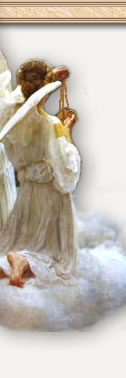




 |
|

|
|
|||||||||||
|
|
|
|
||||||||||||
 |
|
|
||||||||||||
 |
|
 |
|
|||||||||||
|
|
||||||||||||||
 |
 |
|
|
|
|
The Spirituality of the Ancient
Liturgy First of two parts Among liturgists and theologians, it is generally considered true that each form of ritual embodies a kind of spirituality which is proper to that ritual. Thus, for example, the Eastern rites tend to emphasize the mysterious aspects of the spiritual life as well as the role of icons in promoting devotion to Our Lord, Our Lady and the saints. The ancient rite of Mass embodies a spirituality and spiritual lessons that can appeal to every generation and time. By ancient ritual is meant that rite which was codified by St. Gregory the Great and which underwent a very slow organic development over the course of centuries. The last missal promulgated that enjoys that organic growth is that of 1962. It is the common perception in the Church today that the liturgical development of the medieval period was, in fact, decadent and that we must return to the apostolic and early Church period in order to know what real liturgy is as well as God’s will regarding the liturgy. This is, however, a fundamentally flawed notion. Aside from the fact that modern liturgical experts (and by modern I mean of the last 100 years or so) were not accurate in their understanding of the liturgies of the early Church, the notion that medieval liturgical development was somehow an aberration is really a rejection of what was an authentic development based upon the understanding of the Mass as sacrifice. Moreover, such figures like to harken back to an era when the liturgy was supposedly “pristine,” by which they usually mean that it conformed to their faulty theology of the Mass as a meal. The point here is not to give a history lesson, but to explain that one of the premises on which this essay is based is that the ancient rite of Mass is actually the product of the hand of God Who used saints throughout history to develop it according to His holy intention. The desire to reject our liturgical patrimony seems to me to be in fact a desire to reject those things which God has done. Insofar as it is the work of God and the saints, the liturgy embodies certain spiritual principles in the very nature of the ritual that are worthy of reflection. Obviously, we cannot exhaust them all, so we shall limit the discussion to four: 1) the awareness of our sinfulness, 2) the need for self-denial, 3) perfection in virtue and 4) certain aspects about prayer. All of these are essential elements of any sound spiritual life.
I. Awareness of Sin There is of course the Kyrie, which is an appeal for God’s mercy, and before the Gospel the priest asks again that his heart and lips be cleansed. Aside from the Confiteor, perhaps the most notable recollection for the priest for his sins is contained in the offertory prayer Suscipe, sancte Pater. The priest says during this prayer that he offers the spotless Host to “atone for my innumerable sins, offenses, and negligences.” It is necessary for the priest to remind himself constantly of his sinfulness and his proclivity to evil so that he will be motivated to root the sin out of his life. It is also necessary for the priest to do this so that he recognizes his unworthiness to offer the sacrifice and the need to strive for purity and holiness in order to offer it worthily. Since the first step toward sanctified perfection is to be aware of and admit to one’s own sinfulness, these prayers are highly important for the spiritual lives of priests. None of us who are aware of the scandals and sins associated with priests over the past forty years should desire that these prayers be taken out of the offertory or Mass. The laity must desire that the priest be sinless, and one of the ways that is facilitated is by recognizing in the prayers at Mass that he is offering this sacrifice not only for the people but also for himself. If a priest has a sensitive conscience and knows that he must remain pure for the sake of offering the sacrifice, then he merits more graces from God for the people. Today people say that as long as the Mass is valid, the state of the priest does not really matter. While it is true that a priest does not have to be in the state of grace to offer the Mass validly, nevertheless, he has an obligation to be as holy as possible in order to merit more for those under his pastoral care. There are of course two kinds of merit in the Holy Sacrifice of the Mass. The first is Our Lord’s own Sacrifice in which, by the hands of the priest, He is offered to God the Father in expiation for our sins. Here we are referring to the fact that the Mass is the participation in the Sacrifice of Calvary and the merit flowing from this Sacrifice is infinite since That Which is offered is Infinite. But in addition to this essential or primary merit, there is a secondary merit that flows from three things: (1) the holiness of the priest, (2) the holiness of the people who join their own particular sacrifices to the Sacrifice of the priest and (3) the ritual itself. In order for us to gain more fruits from the Mass, we must do everything we can to aid the priest in being holy, e.g., by offering our prayers and mortifications for him so that he will obtain a holiness of life. But this is possible only when the priest is constantly reminded of his ability to fall into sin if he does not rely on the grace of God. It does not help us to ignore this reality and remove it from the ritual. Rather, the awareness of our sinfulness is absolutely necessary for our spiritual advancement, and the ancient ritual is not lacking in this regard. The word culture comes from the Latin word “cultus.” While our subject does not allow us to go too far into the discussion, we should be aware of the fact that the cult – that is, the liturgy or rituals of the predominant religion – actually determines the culture of the society. We have seen this historically during the Protestant revolts and we have even seen it in our own lifetimes: when the Church changed the ritual of the Mass, the Catholic subculture in this nation collapsed. The point here is that if we want to transform our culture, we must have a ritual that possesses a keen awareness of our sinfulness; if we expect our society to have an awareness of sin, the priest when he approaches the altar must have a sense of his sinfulness. Since all graces come into the world by means of the Catholic Church, if our ritual is deficient, then perhaps we are cheating the world of the graces that the ritual we offer is meant to convey.
II. Self Denial, Detachment and Mortification I have had many discussions with laity who come to the old rite for the first time and they often find an appetitive revulsion to the ritual because of the silence. They do not express it exactly that way, of course, but as they talk it becomes clear that they do not like the fact that they are not being talked at and not doing some of the talking themselves. St. John of the Cross used to say that before he would enter into mystical contemplation his “house,” as he called himself, became all quiet; and by this he meant that all of his appetites and faculties had quieted down. This is a sign to us that we must be quiet, we must be stripped of self in order to ascend the heights of perfection, and the old Mass aids that understanding. Moreover, it teaches us that we do not have to be the center of attention by talking in order for the ritual to have a deeper meaning and significance. The old ritual also fosters a sense of detachment on the side of the priest and the people because the ritual is completely determined by Holy Mother the Church. We see in the Old Testament that God gave very detailed instructions on how He was to be worshiped. This is key in understanding the liturgy in two ways. The first is that the liturgy is not our action, it is the action of God by means of the priest; it is not something we do, it is essentially something God does, for the consecration cannot take place without God Who is the first cause of the Sacrifice. The second way is that it is God, and not ourselves, Who determines how we will worship Him. This has been one of the most notable failings in modern times: a desire to determine for ourselves how we will worship God. It is erroneous because it is up to God to tell us the type of worship that pleases or displeases Him and, therefore, only He should be the one to determine the ritual. It was mentioned earlier that God had fashioned the liturgy over the course of time through the saints, who were filled with love of God – everything they did came from Him and led back to Him. The old rite teaches us the important spiritual lesson that if we are going to be holy and pleasing to God, then our task is to conform to the liturgy and not make the liturgy something of our own doing or make it conform to us. Furthermore, since it is God who must determine the ritual, we learn that the Mass is not about us but about God. We are only a secondary aspect of the rite. This is made clear in the ancient ritual in that control over the liturgy is taken away from us, and we thereby recognize that it is not about us. While our desire is to benefit from the Mass, our benefit ultimately must be referred back to God; that is to say, we become holy because it gives God greater glory. So even the aspects that affect us are ultimately about God. The traditional rite, by determining how the ritual is to be done, provides two important spiritual benefits for the priest. The first is peace, for he can go and conform himself to the will of God by following the rubrics of the Mass since they are predetermined; as a priest I cannot say what a great sense of freedom this gives. He does not have to fret over what he will choose and say because he is worried about what the congregation may think. He does not have to listen to a liturgical committee trying to tell him what to do. The second is that it teaches the priest self-denial and sometimes mortification when the ritual is out of his hands. The Mass is not about the priest; it does not have to be sustained by his personality. Obviously only a priest can offer the Mass, but he can lose and forget himself when the whole ritual is determined by the Church, which is the Vox Dei, the Voice of God. It makes it possible for him to forget himself and everything else so that he can perfectly enter into the mystery and the sacred realities present, and thereby derive the greatest benefit from them. In a most perfect fashion, he acts in persona Christi – in the person of Christ – because his own personality is minimized and he can become more like Christ. Since he says Mass facing God and not the people, his own personality, or lack thereof, is not what sustains the ritual. He is able to let his own personality fade into the background so that he can concentrate fully on attending to God. Here when we talk of service, the priest serves God first and foremost. Too often when the term “service” is used in conjunction with the priesthood, it usually means some type of social service, rather than its real meaning of service to God. The old Mass has only two kinds of options, both of which are heavily regulated. The first is that on certain days, according to certain conditions, votive Masses can be said; but that is something exterior to the ritual. The second is that under certain circumstances and on certain days, predetermined optional prayers may be added to the propers, e.g., to pray for rain, for peace, or something of this sort. But these are heavily regulated so that the priest understands that while he may choose to do them, when and how are not entirely up to him. The point is that options within the ritual should be minimized in order to foster obedience to superiors, self-denial and the reduction of self-will, all of which are necessary to the spiritual life. If many options are allowed, it actually militates against the priest’s self-denial and it fosters self-will, since the ritual becomes subject to his choice. It also leaves him with the impression that the liturgy is really his doing rather than an action performed by God through him. Lack of options teaches the priest detachment and it also teaches the laity self-denial because they know they cannot try to manipulate the priest to do in the liturgy what they want, since it is out of his hands. Detachment is key to any discussion of the liturgy and any sound spiritual life. Modern man has lost all detachment regarding the liturgy and he is constantly subjecting it to his appetites. But we need detachment, and any discussion of liturgical restoration requires that people first detach themselves from what they want so that they can know what God wants. Furthermore, the multitude of options and lack of detachment in the liturgy has led to a type of Immanentism. Immanentism is a philosophy or notion which holds that everything of importance is about us and comes from us. If it is not from us, then it has no meaning or significance. Immanentism comes from the two Latin words in and manere which mean to remain in. Since man is incapable of reaching the heavens on his own (Babel and the Pelagian heresies have clearly demonstrated that), the liturgy must be from God and about God in order to draw us out of ourselves and to foster any sense of the transcendent, the striving for which is deeply rooted in the heart of man. The ancient liturgy also provides a depth to one’s spiritual life for three reasons. The first is that it takes us out of ourselves and brings us to God; if we remain in ourselves and if we fashion a liturgy that is at our whim and ultimately about us, then we are doomed to shallowness and superficiality. Rather, insofar as the liturgy is out of our hands, we recognize that it is beyond us, it is mysterious, and insofar as it is about God, it can forever be contemplated. The second is that it is founded on tradition. Tradition provides a mechanism in which man can abandon himself to God who fashions the tradition rather than taking control of it himself and jettisoning the tradition. In other words, tradition provides a mechanism by which the spiritual and liturgical patrimony of the saints can be given to each generation, who can use it to their spiritual benefit. Like someone who does not know his historical roots and therefore does not know himself, modern man has chosen to reject liturgical tradition and replace it with himself, only to be lost in self and never truly to understand himself. Tradition provides a way for the young to ground themselves in the wisdom of the past. This applies not only to cultural things but to the liturgy and the spiritual life as well. The third thing that the ancient liturgy provides is repetition. Now modern man has rejected repetition because he has a fixation on novelty. Novelty, of course, gives our appetites delight but does not necessarily indicate depth. To enter into something in depth requires time and repeated considerations of a thing. Repetitio mater discendi, as we say in Latin: repetition is the mother of learning. This principle applies not only to learning but to our spiritual lives as well. By repeating a prayer, its meaning becomes more known to us and therefore is able to be entered into more perfectly and with greater depth. Since the ancient rite allows not for novelty but repetition, it provides a way in which people can focus on the mysteries present rather than the new things that are constantly popping up. With the silence quieting our faculties and the repetition that characterize each Mass, we are able to participate in and enter more perfectly into the mysteries of the Mass. Too often participation is equated with physical activity rather than the higher and more active form of participation which is spiritual participation.
Fr. Chad Ripperger, F.S.S.P., is a professor at St. Gregory’s diocesan minor seminary and Our Lady of Guadalupe seminary, both in Nebraska. |
|



♦ About The Mass ♦ Resources ♦ How To Help ♦ Contact Us ♦